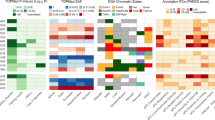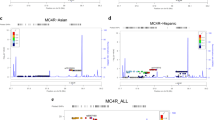Abstract
In genome-wide association (GWA) data from 2,151 nondiabetic French subjects, we identified rs1387153, near MTNR1B (which encodes the melatonin receptor 2 (MT2)), as a modulator of fasting plasma glucose (FPG; P = 1.3 × 10−7). In European populations, the rs1387153 T allele is associated with increased FPG (β = 0.06 mmol/l, P = 7.6 × 10−29, N = 16,094), type 2 diabetes (T2D) risk (odds ratio (OR) = 1.15, 95% CI = 1.08–1.22, P = 6.3 × 10−5, cases N = 6,332) and risk of developing hyperglycemia or diabetes over a 9-year period (hazard ratio (HR) = 1.20, 95% CI = 1.06–1.36, P = 0.005, incident cases N = 515). RT-PCR analyses confirm the presence of MT2 transcripts in neural tissues and show MT2 expression in human pancreatic islets and beta cells. Our data suggest a possible link between circadian rhythm regulation and glucose homeostasis through the melatonin signaling pathway.
This is a preview of subscription content, access via your institution
Access options
Subscribe to this journal
Receive 12 print issues and online access
$209.00 per year
only $17.42 per issue
Buy this article
- Purchase on Springer Link
- Instant access to full article PDF
Prices may be subject to local taxes which are calculated during checkout



Similar content being viewed by others
References
American Diabetes Association. Standards of medical care in diabetes–2008. Diabetes Care 31 (Suppl. 1), S12–S54 (2008).
The Expert Committee on the Diagnosis and Classification of Diabetes Mellitus. Report of the Expert Committee on the Diagnosis and Classification of Diabetes Mellitus. Diabetes Care 20, 1183–1197 (1997).
Tirosh, A. et al. Normal fasting plasma glucose levels and type 2 diabetes in young men. N. Engl. J. Med. 353, 1454–1462 (2005).
Barr, E.L. et al. Risk of cardiovascular and all-cause mortality in individuals with diabetes mellitus, impaired fasting glucose, and impaired glucose tolerance: the Australian Diabetes, Obesity, and Lifestyle Study (AusDiab). Circulation 116, 151–157 (2007).
Bouatia-Naji, N. et al. A polymorphism within the G6PC2 gene is associated with fasting plasma glucose levels. Science 320, 1085–1088 (2008).
Peschke, E. Melatonin, endocrine pancreas and diabetes. J. Pineal Res. 44, 26–40 (2008).
Van Cauter, E. Putative roles of melatonin in glucose regulation. Therapie 53, 467–472 (1998).
Boden, G., Ruiz, J., Urbain, J.L. & Chen, X. Evidence for a circadian rhythm of insulin secretion. Am. J. Physiol. 271, E246–E252 (1996).
Peschke, E. et al. Diabetic Goto Kakizaki rats as well as type 2 diabetic patients show a decreased diurnal serum melatonin level and an increased pancreatic melatonin-receptor status. J. Pineal Res. 40, 135–143 (2006).
Ramracheya, R.D. et al. Function and expression of melatonin receptors on human pancreatic islets. J. Pineal Res. 44, 273–279 (2008).
Dixon, A.L. et al. A genome-wide association study of global gene expression. Nat. Genet. 39, 1202–1207 (2007).
Myers, A.J. et al. A survey of genetic human cortical gene expression. Nat. Genet. 39, 1494–1499 (2007).
Sladek, R. et al. A genome-wide association study identifies novel risk loci for type 2 diabetes. Nature 445, 881–885 (2007).
Balkau, B. An epidemiologic survey from a network of French Health Examination Centres, (D.E.S.I.R.): epidemiologic data on the insulin resistance syndrome. Rev. Epidemiol. Sante Publique 44, 373–375 (1996).
Visvikis-Siest, S. & Siest, G. The STANISLAS Cohort: a 10-year follow-up of supposed healthy families. Gene-environment interactions, reference values and evaluation of biomarkers in prevention of cardiovascular diseases. Clin. Chem. Lab. Med. 46, 733–747 (2008).
Heude, B. et al. Anthropometric relationships between parents and children throughout childhood: the Fleurbaix-Laventie Ville Sante Study. Int. J. Obes. (Lond) 29, 1222–1229 (2005).
Hinds, D.A. et al. Whole-genome patterns of common DNA variation in three human populations. Science 307, 1072–1079 (2005).
Pritchard, J.K., Stephens, M. & Donnelly, P. Inference of population structure using multilocus genotype data. Genetics 155, 945–959 (2000).
Matthews, D.R. et al. Homeostasis model assessment: insulin resistance and beta-cell function from fasting plasma glucose and insulin concentrations in man. Diabetologia 28, 412–419 (1985).
Jorgensen, T. et al. A randomized non-pharmacological intervention study for prevention of ischaemic heart disease: baseline results Inter99. Eur. J. Cardiovasc. Prev. Rehabil. 10, 377–386 (2003).
Wallace, T.M., Levy, J.C. & Matthews, D.R. Use and abuse of HOMA modeling. Diabetes Care 27, 1487–1495 (2004).
Jarvelin, M.R. et al. Ecological and individual predictors of birthweight in a northern Finland birth cohort 1986. Paediatr. Perinat. Epidemiol. 11, 298–312 (1997).
Jaquet, D., Collin, D., Levy-Marchal, C. & Czernichow, P. Adult height distribution in subjects born small for gestational age. Horm. Res. 62, 92–96 (2004).
Hadjadj, S. et al. Prognostic value of the insertion/deletion polymorphism of the ACE gene in type 2 diabetic subjects: results from the Non-insulin-dependent Diabetes, Hypertension, Microalbuminuria or Proteinuria, Cardiovascular Events, and Ramipril (DIABHYCAR), Diabete de type 2, Nephropathie et Genetique (DIAB2NEPHROGENE), and Survie, Diabete de type 2 et Genetique (SURDIAGENE) studies. Diabetes Care 31, 1847–1852 (2008).
Lukowiak, B. et al. Identification and purification of functional human beta-cells by a new specific zinc-fluorescent probe. J. Histochem. Cytochem. 49, 519–528 (2001).
Purcell, S. et al. PLINK: a tool set for whole-genome association and population-based linkage analyses. Am. J. Hum. Genet. 81, 559–575 (2007).
Burton, P.R. et al. Association scan of 14,500 nonsynonymous SNPs in four diseases identifies autoimmunity variants. Nat. Genet. 39, 1329–1337 (2007).
Marchini, J., Howie, B., Myers, S., McVean, G. & Donnelly, P. A new multipoint method for genome-wide association studies by imputation of genotypes. Nat. Genet. 39, 906–913 (2007).
Acknowledgements
The study was supported in part by an ALFEDIAM-Les laboratoires Servier grant, the “Conseil Regional Nord-Pas-de-Calais: Fonds européen de développement économique et regional,” Genome Quebec-Genome Canada and the British Medical Research Council. N.B.-N.'s position is supported by a grant from the ANR (Agence Nationale pour la Recherche: ANR-06 PHYSIO - 037 -02). A.B. is funded by a research fellowship from the French nonprofit “Association pour l'Etude des Anomalies Congénitales.” We acknowledge funding to P.F. by the European Union (Integrated Project EURODIA LSHM-CT-2006-518153 in the Framework Programme 6 [FP06] of the European-Community). We thank M. Deweirder and F. Allegaert for DNA extraction of part of the cohorts studied; S. Gaget and S. Gallina for bioinformatics support; S. Poulain and P. Gallina for the recruitment of obese children families; B. Guardiola-Lemaitre for fruitful discussion on results; and C. Lecoeur for statistical assistance. We acknowledge the “Centre de Médecine Préventive (CMP) de Vandoeuvre-Les-Nancy” where the STANISLAS cohort was recruited. The DESIR study has been supported by INSERM, CNAMTS, Lilly, Novartis Pharma and Sanofi-Aventis, the Association Diabète Risque Vasculaire, the Fédération Française de Cardiologie, La Fondation de France, ALFEDIAM, ONIVINS, Ardix Medical, Bayer Diagnostics, Becton Dickinson, Cardionics, Merck Santé, Novo Nordisk, Pierre Fabre, Roche and Topcon. The Diab-2-Néphrogène/Surdiagène study acknowledges the participating patients, physicians and the staff of the CIC Poitiers, PHRC (Projet Hospitalier de Recherche Clinique), and a 2003-AFD-grant. The NFBC86 is supported by the European Commission; contract number QLG1-CT-2000-01643, Biocenter, University of Oulu, Finland and the Academy of Finland. We thank L. Peltonen for providing NFBC86 DNA samples. The Inter99 study was supported by grants from the Lundbeck Foundation Centre of Applied Medical Genomics for Personalized Disease Prediction, Prevention and Care (LUCAMP), the Danish Medical Research Council, Novo Nordisk, the FOOD Study Group/the Danish Ministry of Food, Agriculture and Fisheries, the Danish Diabetes Association and the European Union (EUGENE2, grant no. LSHM-CT-2004-512013), and from the Swedish Research Council (J.H.).
Author information
Authors and Affiliations
Contributions
N.B.-N. was responsible for the design and data analyses, the study follow-up and the manuscript writing. A.B. was responsible for and performed the gene expression study and was involved in the genotyping of the replication stage, the gene sequencing and the manuscript writing. C.C.-P. performed the statistical analysis in the French and Finnish populations and was involved in the manuscript writing. T.S. and J.H. performed statistical analysis in the Danish samples and were involved in the manuscript writing. M. Marchand was involved in the genotyping of the replication stage, gene expression and gene sequencing. J.D. supervised the genotyping of the GWA data. S.L. and E.D. performed the GWA genotyping. G.R. and R.S. were involved in the type 2 diabetes and obesity GWA studies and the manuscript writing. F.D.G. was involved in the bioinformatics analyses for the GWA studies and the in silico eQTL analyses. J.-C.C. performed the in silico eQTL analyses. K.B.-J., A.-L.H., A.R., J.T., M. Marre, J.W., B.H., M.T., P.E., T.J., G.C., S.H., S.V.-S. and C.L.-M. provided DNA samples and phenotype data. B.B. and M.-R.J. provided DNA samples and phenotype data and were involved in the manuscript writing. T.H. and O.P. provided access to DNA samples and phenotype data, supervised the genotyping and the statistical analyses in the Danish samples and were involved in the manuscript writing. D.M. supervised the obesity GWA study. S.C. and M.V. were involved in the manuscript writing. F.P. provided the human pancreatic islets and sorted beta cells. K.L. and F.S. provided expression data in the mouse. A.I.F.B. and A.J.W. were involved in the obesity GWA study and the manuscript writing. C.D. was involved in the study design and the manuscript writing and supervised the statistical analyses. P.F. was the principal investigator of the study and was involved in the study design and the manuscript writing. All authors approved the data and the final manuscript.
Corresponding author
Supplementary information
Supplementary Text and Figures
Supplementary Tables 1–6 (PDF 340 kb)
Rights and permissions
About this article
Cite this article
Bouatia-Naji, N., Bonnefond, A., Cavalcanti-Proença, C. et al. A variant near MTNR1B is associated with increased fasting plasma glucose levels and type 2 diabetes risk. Nat Genet 41, 89–94 (2009). https://doi.org/10.1038/ng.277
Received:
Accepted:
Published:
Issue Date:
DOI: https://doi.org/10.1038/ng.277



